Reptiles and Amphibians
Media

Species Types
Scientific Name
Coluber constrictor flaviventris (eastern yellow-bellied racer) and Coluber constrictor priapus (southern black racer)
Description
The eastern yellow-bellied racer is uniformly tan, brown, olive, blue, gray, or nearly black on top, with a yellow, cream, or light blue-gray belly. It occurs nearly statewide. The southern black racer subspecies also lives in the southeastern half of the state.
Media

Species Types
Scientific Name
Thamnophis proximus proximus
Description
The orange-striped ribbonsnake is a type of gartersnake named for the attractive orange or yellow stripes running the length of its body, alternating with wide black stripes. It is found statewide, but seldom far from water.
Media
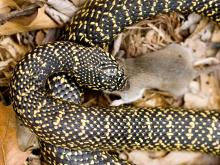
Species Types
Scientific Name
Lampropeltis holbrooki
Description
The speckled kingsnake is generally black, but a white or yellow spot in the center of most of the scales makes it look speckled. The belly is yellowish with some irregular black markings. A harmless, beneficial snake found nearly statewide.
Media

Species Types
Scientific Name
Necturus maculosus maculosus
Description
Mudpuppies are aquatic salamanders that have plumelike external gills throughout their entire lives. They’re found in the southern half and along the eastern edge of Missouri.
Media
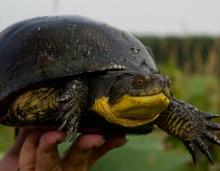
Species Types
Scientific Name
Emydoidea blandingii
Description
Blanding’s turtle has an oval, moderately high-domed upper shell and a long head and neck. This turtle is endangered in Missouri and occurs only in the extreme northern corners of the state.
Media
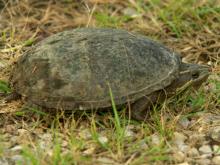
Species Types
Scientific Name
Sternotherus odoratus
Description
The eastern musk turtle is one of the world’s smallest turtles. It has a dark, domed upper shell and reduced lower shell. It occurs along our Mississippi River counties and in the southern two-thirds of the state.
Media
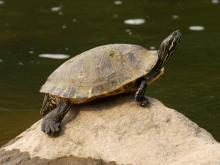
Species Types
Scientific Name
Pseudemys concinna concinna
Description
The eastern river cooter is a broad-shelled aquatic turtle with a seemingly small head. It is most abundant in the rivers and sloughs of southern Missouri but also occurs in some of our large reservoirs.
Media

Species Types
Scientific Name
Graptemys pseudogeographica pseudogeographica
Description
Missouri has two subspecies of false map turtle. The northern false map turtle occurs in the Missouri River in central and northwestern Missouri and the upper Mississippi River. The Mississippi map turtle occurs in the lower Mississippi River, southern Ozark rivers, and southwestern Missouri.
Media
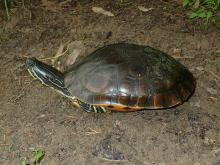
Species Types
Scientific Name
Deirochelys reticularia miaria
Description
The western chicken turtle is a small to medium-sized turtle with an oval shell and extremely long neck. It is endangered in Missouri, occurring only in the Mississippi Lowlands in the extreme southeastern part of the state.
Media

Species Types
Scientific Name
Chrysemys picta bellii
Description
The western painted turtle is a small, brightly colored aquatic turtle. The upper shell is smooth and has a red-orange outer edge. The colorful lower shell has a prominent pattern of brown markings. It is found nearly everywhere in the state except the southeast region.
See Also
About Reptiles and Amphibians in Missouri
Missouri’s herptiles comprise 43 amphibians and 75 reptiles. Amphibians, including salamanders, toads, and frogs, are vertebrate animals that spend at least part of their life cycle in water. They usually have moist skin, lack scales or claws, and are ectothermal (cold-blooded), so they do not produce their own body heat the way birds and mammals do. Reptiles, including turtles, lizards, and snakes, are also vertebrates, and most are ectothermal, but unlike amphibians, reptiles have dry skin with scales, the ones with legs have claws, and they do not have to live part of their lives in water.





















